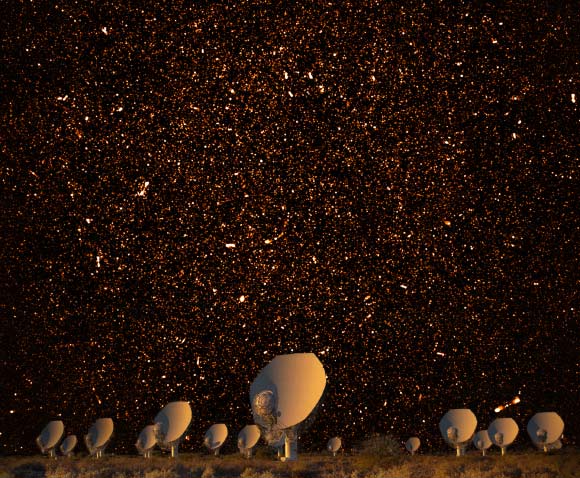MeerKAT Radio Telescope Spots Thousands of Star-Forming Galaxies | Astronomy – Sci-News.com
A new radio image from the MeerKAT telescope at the South African Radio Astronomy Observatory in Cape Town, South Africa, presents a wide portrait of the early Universe and contains tens of thousands of young star-forming galaxies.

This composite image shows thousands of star-forming galaxies in radio light and the MeerKAT radio telescope array in the South African Karoo semidesert. The brightest spots are luminous radio galaxies powered by supermassive black holes. The myriad faint dots are distant star-forming galaxies like our own Milky Way, too faint to have been detected before now. Because radio waves travel at the speed of light, this image is a time machine that samples the star formation history of the Universe. Image credit: SARAO / NRAO / AUI / NSF.
“To make this image, we selected an area in the Southern Sky that contains no strong radio sources whose glare could blind a sensitive observation,” said Dr. Tom Mauch, an astronomer at the South African Radio Astronomy Observatory.
Dr. Mauch and his team used the 64 MeerKAT dishes to observe this area for a total of 130 hours.
“Because radio waves travel at the speed of light, this image is a time machine that samples star formation in these distant galaxies over billions of years,” said Dr. James Condon, a researcher at the National Radio Astronomy Observatory.
“Because only short-lived stars that are less than 30 million years old send out radio waves, we know that the image is not contaminated by old stars. The radio light we see from each galaxy is therefore proportional to its star-forming rate at that moment in time.”
The scientists plan to use this image — dubbed the 1.28 GHz MeerKAT DEEP2 image — to learn more about star formation in the early Universe.
“These first results indicate that the star-formation rate around cosmic noon is even higher than was originally expected,” said Dr. Allison Matthews, a graduate student at the University of Virginia and the National Radio Astronomy Observatory.
“Previous images could only detect the tip of the iceberg, the rare and luminous galaxies that produced only a small fraction of the stars in the Universe. What we see now is the complete picture: these faint dots are the galaxies that formed most of the stars in the Universe.”
“Only in the last few years technology has developed to the point that we can build magnificent telescopes like MeerKAT and have the computing power to create images like this one and get a real understanding of how the Universe came to be the way it is,” said Dr. William Cotton, an astronomer at the National Radio Astronomy Observatory.
“The next generations of instruments, the Square Kilometer Array and the next generation Very Large Array should be even more spectacular.”
The new MeerKAT image is described in a paper to be published in the Astrophysical Journal.
_____
T. Mauch et al. 2019. The 1.28 GHz MeerKAT DEEP2 Image. ApJ, in press; arXiv: 1912.06212





